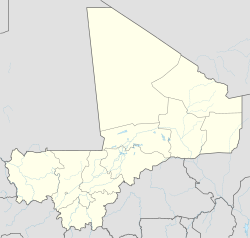Taghaza
| Taghaza | |
|---|---|
| Location within Mali | |
| Coordinates: 23°36′N 5°00′W / 23.600°N 5.000°WCoordinates: 23°36′N 5°00′W / 23.600°N 5.000°W | |
| Country | Mali |
| Time zone | GMT (UTC+0) |
Taghaza (also Teghaza) is an abandoned salt-mining centre located in a salt pan in the desert region of northern Mali. It was an important source of rock salt for West Africa up to the end of the 16th century when it was abandoned and replaced by the salt-pan at Taoudenni which lies 150 km (93 mi) to the southeast. Salt from the Taghaza mines formed an important part of the long distance trans-Saharan trade. The salt pan is located 857 km (533 mi) south of Sijilmasa (in Morocco), 787 km (489 mi) north-northwest of Timbuktu (in Mali) and 731 km (454 mi) north-northeast of Oualata (in Mauritania).
The Taghaza mines are first mentioned by name (as Taghara) in around 1275 by the geographer al Qazwini who spent most of his life in Iraq but obtained information from a traveller who had visited the Sudan. He wrote that the town was situated south of the Maghreb near the ocean and that the ramparts, walls and roofs of the buildings were made of salt which was mined by slaves of the Masufa, a Berber tribe, and exported to the Sudan by a caravan that came once a year. A similar description had been given earlier by Al-Bakri in 1068 for the salt mines at a place that he called Tantatal, situated twenty days from Sijilmasa. It is possible these were the same mines.
In 1352 the Moroccan traveller Ibn Battuta arrived in Taghaza after a 25-day journey from Sijilmasa on his way across the Sahara to Oualata to visit the Mali Empire. According to Ibn Battuta, there were no trees, only sand and the salt mines. Nobody lived in the village other than the Musafa slaves who dug for the salt and lived on dates imported from Sijilmasa and the Dar'a valley, camel meat and millet imported from the Sudan. The buildings were constructed from slabs of salt and roofed with camel skins. The salt was dug from the ground and cut into thick slabs, two of which were loaded onto each camel. The salt was taken south across the desert to Oualata and sold. The value of the salt was chiefly determined by the transport costs. Ibn Battuta mentions that the value increased fourfold when transported between Oualata and the Malian capital. In spite of the meanness of the village, it was awash in Malian gold. Ibn Battuta did not enjoy his visit; he found the water brackish and the village full of flies.
...
Wikipedia

